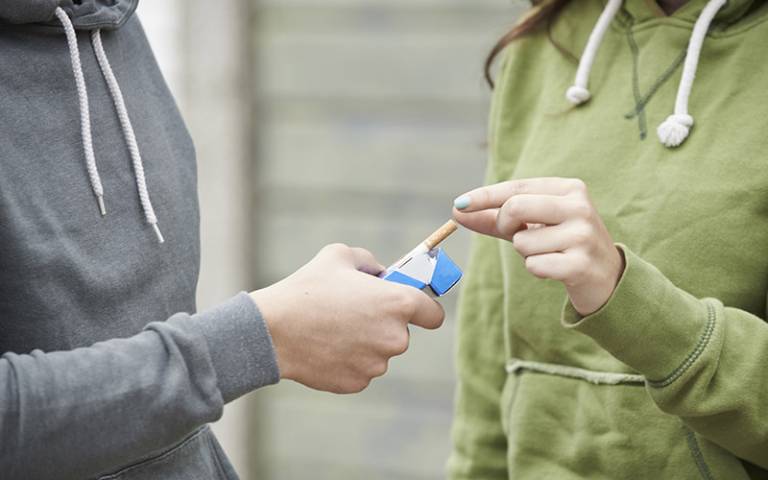Decline in smoking in England has stalled since pandemic
14 December 2023
A decades-long decline in smoking prevalence in England has nearly ground to a halt since the start of the pandemic, according to a new study led by UCL researchers.

The study, funded by Cancer Research UK and published in the journal BMC Medicine, looked at survey responses from 101,960 adults between June 2017 and August 2022.
Before the Covid-19 pandemic, from June 2017 to February 2020, smoking prevalence fell by 5.2% a year, but this rate of decline slowed to 0.3% during the pandemic (from April 2020 to August 2022), the study found. This stall in the decline of smoking was particularly pronounced among advantaged social groups.
Lead author Dr Sarah Jackson (UCL Institute of Epidemiology & Health Care) said: “Smoking prevalence has been falling among adults in England at a steady rate for more than 20 years. Our data show that this decline has stalled, with an increase in quitting potentially having been offset by a rise in people taking up smoking or an increase in late relapse.
“These findings make bold policy action more urgent. The Government was already not on track to meet its target for England to be smokefree by 2030. This study shows we are even further off track than we thought.”
Based on the survey responses, the researchers estimated the proportion of smokers in England as 16.2% in June 2017, falling to 15.1% by the start of the pandemic (in March 2020). Nearly two and a half years later, in August 2022, this figure was virtually unchanged, at 15.0%.
The researchers used data from the Smoking Toolkit Study, in which a different sample of 1,700 adults in England (who are representative of the population) are interviewed each month. They aimed to see if the pandemic, which had such a profound impact on everyday life, had resulted in sustained changes in smoking patterns.
The team found a 40% increase in quit attempts during the pandemic compared to pre-pandemic and a sustained 120% increase in the proportion of people stopping smoking (i.e., this figure more than doubled), but this was offset by a rise in the number of people taking up smoking during the same period.
They also found that smoking prevalence had increased among 18- to 24-year-olds at the start of the pandemic, and decreased among 45- to 65-year-olds at the same time. They noted that younger adults experienced higher levels of stress, upheaval, and social isolation during the pandemic, which might have contributed to increased smoking prevalence. In both age groups, these immediate changes were followed by the pre-pandemic declines stopping, and prevalence remaining flat.
The researchers cautioned that these immediate changes might conceivably have been partly a result of survey interviews moving from face to face (before March 2020) to over the phone (from April 2020). Changes in trends – including the levelling-off of the decline in smoking prevalence – were unlikely to have been caused by the change in methodology.
The flattening in the decline of smoking prevalence was particularly pronounced among advantaged social groups - that is, people in households whose highest earners were in professional, managerial or clerical jobs, as opposed to manual jobs (ABC1).
Among people in disadvantaged social groups (C2DE, i.e. households whose highest earners are in manual, semi- or unskilled jobs, or are unemployed), smoking prevalence continued to decline very slightly.
The researchers said the switch to home working for many non-manual jobs during the pandemic may have contributed to loneliness and poor mental health, making people in those jobs less inclined to quit smoking.
Manual workers, meanwhile, may have had more financial disruption, leading to smoking becoming less affordable, as well as increased exposure to Covid-19 due to work, making quitting a higher priority for health reasons.
“In working toward the smokefree 2030 target,” the researchers wrote, “there is a need for action to reignite progress in reducing smoking among the more advantaged social grades and identify ways to accelerate the decline among less advantaged groups.”
The UK Government is aiming for England to be smokefree by 2030, defined as adult smoking rates of 5% or less. An independent review in 2022 concluded that without further action, England would miss this target by at least seven years. Wales also has a 2030 target, while Scotland’s smokefree target is 2034.
Senior author Professor Jamie Brown (UCL Institute of Epidemiology & Health Care) said: “The Government’s proposal to make it an offence to sell tobacco products to anyone born after 2008 could get us much closer to a smokefree 2030. Other bold actions that have been proposed, such as increasing investment in mass media campaigns and distributing a million e-cigarettes to smokers, could also make a significant difference.”
Dr Ian Walker, Cancer Research UK’s executive director of policy, said: "These findings demonstrate why we can’t be complacent when it comes to tobacco. It can be easy to start smoking but notoriously hard to quit.
“World-leading measures, such as changing the age of sale of tobacco, alongside critical funding to boost smoking cessation services, are essential to help us achieve a Smokefree UK. We call on MPs from all parties to support the age of sale legislation at the free vote.”
Links
- The paper in BMC Medicine
- Dr Sarah Jackson’s academic profile
- Professor Jamie Brown’s academic profile
- UCL Institute of Epidemiology & Health Care
- UCL Population Health Sciences
- Cancer Research UK
- UCL’s Smoking Toolkit Study
Image
- Credit: iStock / Highwaystarz-Photography
Media contact
Mark Greaves
m.greaves [at] ucl.ac.uk
+44 (0)20 3108 9485
 Close
Close

